First Production Motorcycle in the World
In motorized two-wheelers, the “first” production motorcycle debate unfolds with a blend of history and innovation. From steam-powered velocipedes to the advent of gasoline engines, each model proposed as the earliest motorcycle tells a unique story of technological progress and cultural impact. This article delves into the histories, beliefs, and pros and cons of three contenders for the title of the first production motorcycle: the 1894 Hildebrand & Wolfmüller, the Michaux-Perreaux steam velocipede, and the Roper steam velocipede.
1. 1894 Hildebrand & Wolfmüller
The 1894 Hildebrand & Wolfmüller stands as a significant milestone in the evolution of transportation, marking a pivotal shift from traditional horse-drawn carriages to the era of gasoline-powered mobility. Created by German brothers Heinrich and Wilhelm Hildebrand, who teamed up with inventor Alois Wolfmüller and mechanic Hans Geisenhof, this motorcycle is renowned for being the first gasoline-powered vehicle to be mass-produced. Its groundbreaking design and impact paved the way for the modern motorcycling world.
Pros of the 1894 Hildebrand & Wolfmüller:
Revolutionary Engineering: Featuring a twin-cylinder, four-stroke engine, the Hildebrand & Wolfmüller brought forth an innovative design ahead of its time, utilizing principles similar to those of a steam locomotive.
Mass Production: As the first motorcycle to be produced on a mass scale, it was initially believed that approximately 2,000 units were manufactured. This not only democratized motorized transport by making it more accessible but also catalyzed further developments in vehicle technology.
Cultural Impact: The introduction of this motorcycle significantly changed public perceptions of transportation, offering a new sense of freedom and independence that was previously unimaginable.
Cons of the 1894 Hildebrand & Wolfmüller:
Challenging Startup: The motorcycle lacked a kickstart mechanism or pedals, requiring it to be started with a push. This could be pretty cumbersome and was a significant drawback for practical everyday use.
Basic Braking System: It uses wooden brakes that apply pressure directly to the front tyre. These brakes are primitive and provide limited stopping power, which poses safety risks at higher speeds.
Maintenance and Reliability: Like many first-generation technological innovations, Hildebrand & Wolfmüller suffered reliability issues. Frequent maintenance and mechanical failures were standard, which could be frustrating and costly for its owners.
Despite being an iconic part of automotive history, the Munich-based factory faced numerous challenges. Production had to be stopped after less than four years, and the factory became uncompetitive. Although the Hildebrand & Wolfmüller had a low frame made from steel tubes and a horizontal four-stroke twin-cylinder engine developing 25hp at 240 rpm, with a 90mm bore and 117mm stroke for a capacity of 1488CC, it wasn’t enough to sustain long-term success. The connecting rods of both cylinders, directly connected to the rear wheel, which also acted as the flywheel, and the rear mudguard that housed the radiator for water cooling the engine were unique features that ultimately did not translate into a durable product. The number of machines made is uncertain, with some sources claiming 800 and others 2000. Nonetheless, this motorcycle remains a testament to early engineering brilliance and ambition.
The 1894 Hildebrand & Wolfmüller symbolizes the ingenuity of early automotive engineering and the challenges faced by pioneering technologies. Though debated in numbers, its production remains a testament to its impact and popularity during its time, setting foundational standards for the future of motorized two-wheeled vehicles.
2. Michaux-Perreaux Steam Velocipede
The Michaux-Perreaux Steam Velocipede created between 1867 and 1871, marks an early chapter in the evolution of motorized transportation. This innovative machine emerged from the collaboration between Louis-Guillaume Perreaux, a steam engine designer, and Pierre Michaux, a bicycle manufacturer renowned for his pedal bicycles. Together, they crafted one of the first motorized two-wheelers by attaching a small commercial steam engine to an iron-framed bicycle, marking a significant achievement in the history of transportation technology.
Pros of the Michaux-Perreaux Steam Velocipede:
- Pioneering Technology: This velocipede was among the earliest to integrate a steam engine with a bicycle frame, making it a groundbreaking step in motorized transport.
- Engineering Marvel: Adapting a compact steam engine to fit within the confines of a bicycle frame demonstrated remarkable ingenuity and foresight in mechanical design.
- Historical Significance: As one of the three vehicles claimed to be the first true motorcycle, its development was crucial in setting the stage for future innovations in powered personal transportation.
Cons of the Michaux-Perreaux Steam Velocipede:
Operational Challenges: The velocipede’s reliance on steam power meant it was heavier than non-motorized bicycles, complicating its operation and manoeuvrability.
Safety Risks: The steam engine posed several risks, including burns from the hot boiler and potential mechanical failures from the intricate system required to operate under steam pressure.
Limited Impact and Production: Produced in very small numbers—around 100 were sold—the Michaux-Perreaux Steam Velocipede did not achieve mass production or widespread use, limiting its impact on the broader public and its role in the evolution of motorized vehicles.
The Michaux-Perreaux Steam Velocipede is a testament to the early experimental phase of motorcycle development. While it demonstrated the potential of steam-powered personal transport, its practical limitations underscored the challenges of early vehicular innovations. They later paved the way for adopting more efficient and reliable internal combustion engines.
3. Roper Steam Velocipede
The Roper Steam Velocipede, developed by Sylvester H. Roper of Roxbury, Boston, Massachusetts, represents a pivotal innovation in the annals of motorized transport. Built between 1867 and 1869, this steam-powered velocipede is one of the earliest forerunners of what would later be recognized as motorcycles. Alongside the Michaux-Perreaux and the 1885 Daimler Reitwagen, it is one of the primary claimants to the title of the first motorcycle. Sylvester Roper, an inventor and a visionary, incorporated a small steam engine into the then-popular safety bicycle frame, showcasing a blend of mechanical ingenuity and practical application.
Pros of the Roper Steam Velocipede:
Innovative Design: The Roper velocipede featured a custom-built steam engine that was ingeniously integrated into the frame of a safety bicycle, showcasing early attempts at seamless design integration in personal transport vehicles.
Advanced Features for Its Time: The machine included a water tank and a coal-fired boiler, which were revolutionary in powering a two-wheeled vehicle, thus pushing the boundaries of what was mechanically possible at that time.
Historical Importance: The Roper Steam Velocipede is recognized for its significant role in the history of motorized vehicles. It was just made around 9, influencing future designs and concepts in the motorcycle industry.
Cons of the Roper Steam Velocipede:
Operational Complexity: Managing a steam-powered vehicle required handling the boiler, maintaining steam pressure, and refuelling with coal, which made it less practical for everyday use compared to later gasoline-powered motorcycles.
Safety Concerns: The inherent risks of operating a steam engine, such as the potential for explosions and burns, posed serious safety concerns for users.
Limited Production and Impact: Like the Michaux-Perreaux, the Roper Steam Velocipede was never mass-produced. It remained a prototype and an experimental model, which limited its impact on mainstream transportation and its practical utility for the general public.
The Roper Steam Velocipede illustrates the experimental spirit of its time and highlights the technological challenges and risks associated with early steam-powered transport. Its legacy lies in its contribution to the evolution of motorcycles, serving as a stepping stone towards more practical and sustainable innovations in motorized two-wheelers.
Each of these machines contributed uniquely to the development of motorized two-wheel transport, reflecting both the technological ambitions and the limitations of their times. The Hildebrand & Wolfmüller, with its ambitious mass production and relatively advanced engine technology, brought the motorcycle concept to a broader audience, setting a precedent for future developments. In contrast, the steam-powered velocipedes by Michaux-Perreaux and Sylvester Roper offered early glimpses into alternative propulsion methods. However, they ultimately faced limitations in efficiency and practicality that gasoline engines would soon overcome.
As we explore these fascinating early production motorcycles, it’s clear that each model not only pushed the boundaries of what was technically possible but also shaped the path for future innovations in motorcycle engineering.








No comment